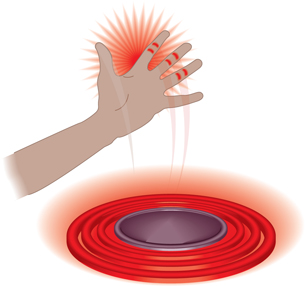Module 1
1. Module 1
1.13. Lesson 3
Module 1—The Nervous System
Lesson 3—the Neuron and the Reflex Arc
 Get Focused
Get Focused
In the Big Picture you were introduced to the new girl in school, who you hoped would be your new friend. You shook hands with her when you were introduced, but your response to the handshake surprised you! You withdrew your hand right away—the finger you sprained in basketball practice hurt. How embarrassing!
reflex arc: an involuntary neural pathway that consists of a sensory receptor, a sensory neuron, a control centre that can be either the brain or the spinal cord, a motor neuron, and an effector that results in a reflex behaviour that usually has survival value
It may have been embarrassing, but your body knows what it’s doing. This immediate “no-brainer” response is exactly that—a “no brainer.” Your brain is not involved in this response. You didn’t think about the response. Instead, your spinal cord immediately responded to a “danger” signal and sent messages to your body for appropriate, fast responses to minimize tissue damage. This is called a reflex arc.
Other examples include pulling your hand away from a hot stove, quickly lifting your foot when you step on a tack, or swinging your leg up when the doctor taps your knee with a reflex hammer. In these cases, there is an immediate response—the “no-brainer” response. You jerk your hand away, lift your foot, or swing your leg. Then, other responses follow shortly afterwards. You may be embarrassed, cry out in pain, or respond in some other way. In these later responses, your brain is involved in processing information.

Why is the initial reaction so fast? Why did you become aware that the handshake hurt or that the stove was hot and respond afterwards?
neuron: a cell in the nervous system that generates and transmits nerve impulses; consists of dendrites, a cell body containing the nucleus, and an axon that may or may not have a myelin sheath
sensory neuron: a type of nerve cell that receives stimuli and conducts an impulse toward the brain and the spinal cord (central nervous system)
interneuron: a type of nerve cell found either in the brain or the spinal cord that transmits nerve impulses from sensory neurons within the various parts of the brain or to motor neurons
motor neuron: a type of nerve cell that transmits nerve impulses toward an effector, which can be a muscle or a gland
effector: one of the three types of muscle or a gland that responds to a nerve impulse
In this lesson you will study more about these types of reactions and the supporting structure and function of the neuron. Neurons are the specialized cells of the nervous system. These cells make it possible for you to see a person across the room, hear laughter, and smell a fragrance. You will examine how the neuron’s design can aid the speed of communication and how changes in its structure can result in an interruption in communication.
In Lesson 1 you learned about the three basic types of neurons and how each one carries out a specific function in the basic neural pathway. Sensory neurons communicate messages from the body to the central nervous system. Interneurons process information and communicate messages through motor neurons to effectors to produce a response. In this lesson you will examine the features of a neural pathway called the reflex arc. You will come to understand how this communication pathway produces extremely rapid responses that protect you and ensure your survival.
This lesson helps you to understand the following focusing questions:
- What are the structures and functions of the neuron? How do they support communication?
- What are the components of the reflex arc?
 Module 1: Lesson 3 Assignment
Module 1: Lesson 3 Assignment
Your teacher-marked Module 1: Lesson 3 Assignment requires you to submit a response to the following:
- Lab Part 1
- Lab Part 2
Download a copy of the Module 1: Lesson 3 Assignment to your computer now. You will receive further instructions about how to complete this assignment later in the lesson.
You must decide what to do with the questions that are not marked by the teacher.
Remember that these questions provide you with the practice and feedback that you need to successfully complete this course. You should respond to all of the questions and place those answers in your course folder.
In Lesson 3 you will continue to work on your Module Assessment project by researching how the changes in the structure and function of the neuron could lead to the communication problems that exist in Alzheimer’s disease. You will consider whether or not there are any changes in the reflex arcs of patients with this disease. Your research will be stored in your course folder.
Required Materials and Equipment
In order to complete one of the labs, you will need cotton balls and a 20 cm x 20 cm clear plastic sheet.